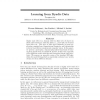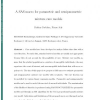75 search results - page 6 / 15 » Learning mixture models using a genetic version of the EM al... |
NIPS
1998
13 years 9 months ago
1998
Dyadic data refers to a domain with two nite sets of objects in which observations are made for dyads, i.e., pairs with one element from either set. This type of data arises natur...
DASFAA
2004
IEEE
13 years 11 months ago
2004
IEEE
Text classification using a small labeled set and a large unlabeled data is seen as a promising technique to reduce the labor-intensive and time consuming effort of labeling traini...
PAMI
2006
13 years 7 months ago
2006
We describe an algorithm for context-based segmentation of visual data. New frames in an image sequence (video) are segmented based on the prior segmentation of earlier frames in ...
ICDM
2006
IEEE
14 years 1 months ago
2006
IEEE
In spite of the initialization problem, the ExpectationMaximization (EM) algorithm is widely used for estimating the parameters in several data mining related tasks. Most popular ...
CMPB
2007
13 years 7 months ago
2007
: Cure models have been developed to analyze failure time data with a cured fraction. For such data, standard survival models are usually not appropriate because they do not accoun...


